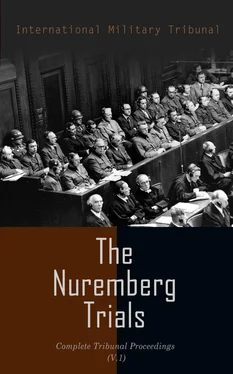Crimes committed in France or Against French citizens took the following forms:
Arbitrary arrests were carried out under political or racial pretexts: they were both individual and collective; notably in Paris (round-up of the 18th Arrondissement by the Field Gendarmerie, round-up of the Jewish population of the 11th Arrondissement in August 1941, round-up of Jewish intellectuals in December 1941, round-up in July 1942); at Clermont-Ferrand (round-up of professors and students of the University of Strasbourg, who were taken to Clermont-Ferrand on 25 November 1943); at Lyons; at Marseilles (round-up of 40,000 persons in January 1943); at Grenoble (round-up on 24 December 1943); at Cluny (round-up on 24 December 1944); at Figeac (round-up in May 1944); at Saint Pol de Léon (round-up in July 1944); at Locminé (round-up on 3 July 1944); at Eysieux (round-up in May 1944) and at Moussey (round-up in September 1944). These arrests were followed by brutal treatment and tortures carried out by the most diverse methods, such as immersion in icy water, asphyxiation, torture of the limbs, and the use of instruments of torture, such as the iron helmet and electric current, and practiced in all the prisons of France, notably in Paris, Lyons, Marseilles, Rennes, Metz, Clermont-Ferrand, Toulouse, Nice, Grenoble, Annecy, Arras, Béthune, Lille, Loos, Valenciennes, Nancy, Troyes, and Caen, and in the torture chambers fitted up at the Gestapo centers.
In the concentration camps, the health regime and the labor regime were such that the rate of mortality (alleged to be from natural causes) attained enormous proportions, for instance:
|
1. Out of a convoy of 230 French women deported from Compiègne to Auschwitz in January 1943, 180 died of exhaustion by the end of four months. |
|
2. 143 Frenchmen died of exhaustion between 23 March and 6 May 1943, in Block 8 at Dachau. |
|
3. 1,797 Frenchmen died of exhaustion between 21 November 1943, and 15 March 1945, in the Block at Dora. |
|
4. 465 Frenchmen died of general debility in November 1944, at Dora. |
|
5. 22,761 deportees died of exhaustion at Buchenwald between 1 January 1943, and 15 April 1945. |
|
6. 11,560 detainees died of exhaustion at Dachau Camp (most of them in Block 30 reserved for the sick and the infirm) between 1 January and 15 April 1945. |
|
7. 780 priests died of exhaustion at Mauthausen. |
|
8. Out of 2,200 Frenchmen registered at Flossenburg Camp, 1,600 died from supposedly natural causes. |
Methods used for the work of extermination in concentration camps were:
Bad treatment, pseudo-scientific experiments (sterilization of women at Auschwitz and at Ravensbrück, study of the evolution of cancer of the womb at Auschwitz, of typhus at Buchenwald, anatomical research at Natzweiler, heart injections at Buchenwald, bone grafting and muscular excisions at Ravensbrück, etc.), gas chambers, gas wagons, and crematory ovens. Of 228,000 French political and racial deportees in concentration camps, only 28,000 survived.
In France systematic extermination was practiced also, notably at Asq on 1 April 1944, at Colpo on 22 July 1944, at Buzet-sur-Tarn on 6 July 1944 and on 17 August 1944, at Pluvignier on 8 July 1944, at Rennes on 8 June 1944, at Grenoble on 8 July 1944, at Saint Flour on 10 June 1944, at Ruisnes on 10 July 1944, at Nimes, at Tulle, and at Nice, where, in July 1944, the victims of torture were exposed to the population, and at Oradour-sur-Glane where the entire village population was shot or burned alive in the church.
The many charnel pits give proof of anonymous massacres. Most notable of these are the charnel pits of Paris (Cascade du Bois de Boulogne), Lyons, Saint-Genis-Laval, Besançon, Petit-Saint-Bernard, Aulnat, Caen, Port-Louis, Charleval, Fontainebleau, Bouconne, Gabaudet, L’hermitage Lorges, Morlaas, Bordelongue, Signe.
In the course of a premeditated campaign of terrorism, initiated in Denmark by the Germans in the latter part of 1943, 600 Danish subjects were murdered and, in addition, throughout the German occupation of Denmark, large numbers of Danish subjects were subjected to torture and ill-treatment of all sorts. In addition, approximately 500 Danish subjects were murdered, by torture and otherwise, in German prisons and concentration camps.
In Belgium between 1940 and 1944 tortures by various means, but identical in each place, were carried out at Brussels, Liége, Mons, Ghent, Namur, Antwerp, Tournai, Arlon, Charleroi, and Dinant.
At Vught, in Holland, when the camp was evacuated about 400 persons were murdered by shooting.
In Luxembourg, during the German occupation, 500 persons were murdered and, in addition, another 521 were illegally executed, by order of such special tribunals as the so-called “Sondergericht”. Many more persons in Luxembourg were subjected to torture and mistreatment by the Gestapo. Not less than 4,000 Luxembourg nationals were imprisoned during the period of German occupation, and of these at least 400 were murdered.
Between March 1944 and April 1945, in Italy, at least 7,500 men, women, and children, ranging in years from infancy to extreme old age were murdered by the German soldiery at Civitella, in the Ardeatine Caves in Rome, and at other places.
2. In the U.S.S.R., i. e., in the Bielorussian, Ukrainian, Estonian, Latvian, Lithuanian, Karelo-Finnish, and Moldavian Soviet Socialist Republics, in 19 regions of the Russian Soviet Federated Socialist Republic, and in Poland, Czechoslovakia, Yugoslavia, Greece, and the Balkans (hereinafter called “the Eastern Countries”) and in that part of Germany which lies east of a line drawn north and south through the center of Berlin (hereinafter called “Eastern Germany”).
From 1 September 1939, when the German Armed Forces invaded Poland, and from 22 June 1941, when they invaded the U.S.S.R., the German Government and the German High Command adopted a systematic policy of murder and ill-treatment of the civilian populations of and in the Eastern Countries as they were successively occupied by the German Armed Forces. These murders and ill-treatments were carried on continuously until the German Armed Forces were driven out of the said countries.
Such murders and ill-treatments included:
(a) Murders and ill-treatments at concentration camps and similar establishments set up by the Germans in the Eastern Countries and in Eastern Germany including those set up at Maidanek and Auschwitz.
The said murders and ill-treatments were carried out by divers means including all those set out above, as follows:
About 1,500,000 persons were exterminated in Maidanek and about 4,000,000 persons were exterminated in Auschwitz, among whom were citizens of Poland, the U.S.S.R., the United States of America, Great Britain, Czechoslovakia, France, and other countries.
In the Lwow region and in the city of Lwow the Germans exterminated about 700,000 Soviet people, including 70 persons in the field of the arts, science, and technology, and also citizens of the United States of America, Great Britain, Czechoslovakia, Yugoslavia, and Holland, brought to this region from other concentration camps.
In the Jewish ghetto from 7 September 1941 to 6 July 1943, over 133,000 persons were tortured and shot.
Mass shooting of the population occurred in the suburbs of the city and in the Livenitz forest.
In the Ganov camp 200,000 peaceful citizens were exterminated. The most refined methods of cruelty were employed in this extermination, such as disembowelling and the freezing of human beings in tubs of water. Mass shootings took place to the accompaniment of the music of an orchestra recruited from the persons interned.
Читать дальше












